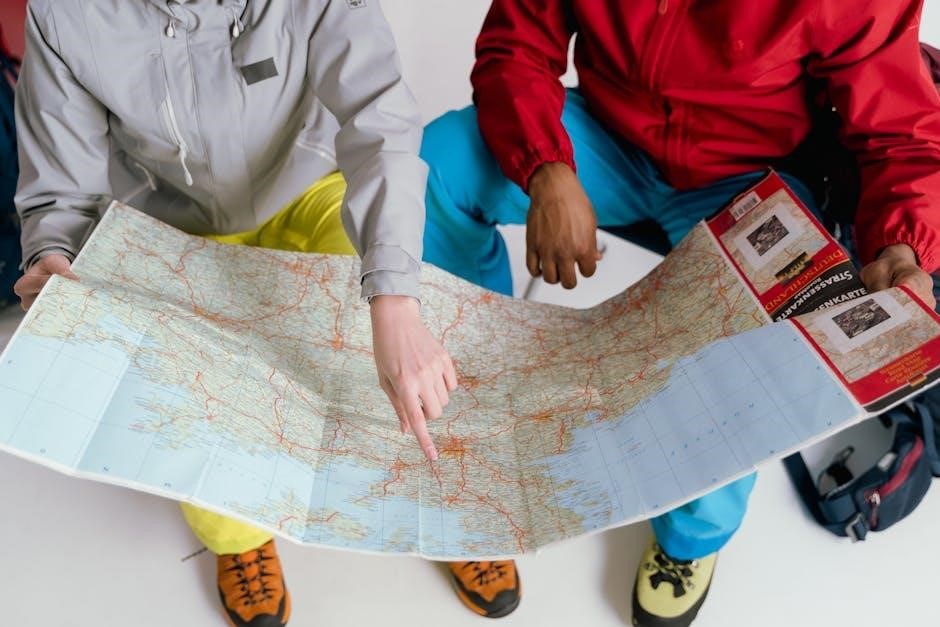Choosing the right backpack size is crucial for comfort and functionality. This guide helps you understand torso measurements, capacity, and how to select the perfect fit for your needs.
Why Choosing the Right Backpack Size Matters
Choosing the right backpack size is essential for comfort, functionality, and efficiency. A backpack that is too large or too small can lead to discomfort, poor weight distribution, and reduced mobility. Proper sizing ensures optimal weight distribution, reducing strain on your shoulders and back. It also guarantees that your gear fits securely without overcrowding or shifting during movement. Whether for daily use or outdoor adventures, a well-fitting backpack enhances your overall experience and performance. This guide helps you make informed decisions to find the perfect size for your needs and activities.

Understanding Torso Measurement
Torso measurement is key to determining the right backpack size. It is measured from the C7 vertebra at the base of the neck to the hip area, ensuring proper fit and weight distribution.

How to Measure Your Torso Length
To measure your torso length, start by locating the C7 vertebra at the base of your neck. This is the bony protrusion visible when you tilt your head forward. From this point, measure straight down to the top of your hip bones, keeping the tape measure level and parallel to the ground. Stand upright with shoulders relaxed for accuracy. This measurement determines your torso length, which is essential for selecting a backpack that fits properly and distributes weight evenly. Ensure the tape measure is snug but not tight for the most accurate reading.
Importance of Torso Fit for Backpack Comfort
A proper torso fit ensures optimal weight distribution, reducing shoulder strain and improving comfort. A backpack that matches your torso length allows the hip belt to sit correctly, transferring most of the weight to your hips. This prevents discomfort and fatigue during extended wear. A poor fit can lead to uneven weight distribution, affecting posture and causing long-term discomfort. Ensuring your backpack fits your torso length is essential for maximizing comfort, breathability, and overall performance, making it a critical factor in choosing the right backpack size for any activity or journey.

Standard Backpack Size Categories
Backpacks are categorized into small, medium, and large sizes, based on torso length and capacity in liters, ensuring a tailored fit for various needs and activities.
Small, Medium, and Large Backpack Sizes
Backpack sizes are typically categorized into small, medium, and large, catering to different torso lengths and capacities. Small backpacks, ideal for day trips or short adventures, usually fit torsos under 18 inches and hold 20-30 liters. Medium backpacks, suitable for most users, accommodate torsos between 18-20 inches and offer 30-40 liters of space. Large backpacks are designed for longer trips or taller individuals, fitting torsos over 20 inches with capacities of 40-50 liters or more. Each size ensures optimal comfort and functionality, making it essential to match your torso length to the backpack’s fit for the best experience.
Understanding Backpack Capacity in Liters
Backpack capacity, measured in liters, determines how much gear you can carry. Small backpacks typically range from 20-30 liters, ideal for day trips or minimalists. Medium backpacks, 30-40 liters, are versatile for everyday use or short adventures. Large backpacks, 40-50 liters or more, are designed for extended trips or heavy loads. Capacity also varies by activity, with specialized backpacks for hiking, travel, or school. Choosing the right size ensures you carry essentials without overpacking, balancing comfort and functionality for your specific needs.

How to Choose the Right Backpack Size
Choosing the right backpack size involves measuring your torso and hips, then matching these to the pack’s dimensions. Consider your activity and adjust straps for optimal comfort.
Matching Backpack Size to Your Torso Length
Your torso length is the most critical measurement for selecting a backpack. Measure from the base of your neck (C7 vertebra) to your hipbone. This ensures proper weight distribution and comfort. A backpack that fits your torso length aligns with your body’s natural posture, preventing strain. Use your torso measurement to choose between small, medium, or large sizes. Most backpacks are designed with adjustable straps, so ensure the hipbelt sits comfortably on your hips. A well-fitted backpack improves balance and reduces fatigue during long hikes or daily commutes. Always prioritize torso fit for optimal comfort and performance.
Considering Hip Size for Weight Distribution
Hip size plays a significant role in backpack fit, as it affects how weight is distributed. A properly fitted hipbelt ensures the majority of the pack’s weight rests on your hips, reducing shoulder strain. Measure your natural waistline or hipbone level to determine the ideal hipbelt size. Ensure the hipbelt is snug but not restrictive, allowing for even weight distribution. Backpacks with adjustable hipbelts cater to various body types, promoting comfort and reducing fatigue. Proper hip fit enhances overall carrying efficiency, making long hikes or daily use more enjoyable and stress-free.

Backpack Sizes for Different Purposes
Backpack sizes vary based on use, from daypacks for daily commutes to larger packs for multi-day trips. Choose the right size for your activity to ensure comfort and efficiency.
Daypacks vs. Multi-Day Backpacks
Daypacks are ideal for short trips or daily use, typically ranging from 15-30 liters, while multi-day backpacks (50-80 liters) are designed for extended adventures. Daypacks prioritize lightweight designs and essential features like laptop compartments, making them perfect for commutes or hikes. Multi-day backpacks focus on durability, weight distribution, and ample storage for gear. Both styles emphasize torso fit and comfort but cater to different needs. Choosing the right size ensures optimal performance, whether you’re navigating city streets or wilderness trails. Always consider your activity and duration to select the perfect backpack for your journey.
Backpack Sizes for Specific Activities
Backpack sizes vary based on activity, ensuring optimal performance. Hiking requires 30-50 liters for multi-day trips, while school backpacks (20-30 liters) focus on organization. Travel backpacks (40-60 liters) prioritize comfort and capacity. Cycling backpacks (15-25 liters) emphasize lightweight designs for mobility. Winter sports demand larger sizes (50-70 liters) for bulky gear. Each activity dictates unique needs, from durability to weight distribution. Matching backpack size to your pursuit ensures comfort and efficiency, whether navigating trails or urban environments. Always consider the specific demands of your activity to choose the right backpack for unmatched performance and convenience.

Measuring Yourself for the Perfect Fit
Accurate measurements ensure a comfortable backpack fit. Measure your torso from the C7 vertebra to hip bones using a tape measure. Proper fit enhances comfort and performance.
Using a Tape Measure for Accurate Fit
To ensure an accurate fit, use a flexible tape measure to determine your torso length. Start by locating the C7 vertebra at the base of your neck. Measure straight down to the top of your hip bones, keeping the tape measure level and parallel to the ground. Stand upright and relaxed to get the most precise measurement. If possible, have someone assist you for accuracy. This method helps you find the ideal backpack size that aligns with your body proportions, ensuring optimal comfort and weight distribution during use.
How to Adjust Shoulder and Hip Straps
Properly adjusting shoulder and hip straps ensures optimal comfort and weight distribution. Start by fastening the hip belt snugly around your waist, resting it on your iliac crest for proper support. Adjust the shoulder straps to fit comfortably without restricting movement, ensuring the pack sits close to your back. Tighten or loosen the straps as needed to distribute weight evenly. For the best fit, the shoulder straps should wrap around your shoulders without digging in, while the hip belt should bear the majority of the weight. This ensures a balanced and comfortable carry for extended periods.
Weight Distribution and Backpack Size
Backpack size significantly impacts weight distribution. A properly fitted pack supports your lower back and ensures even weight distribution between shoulders and hips, preventing discomfort and fatigue.
How Backpack Size Affects Weight Distribution
Backpack size directly influences weight distribution, impacting comfort and posture. A backpack that’s too large can cause weight to shift unevenly, straining shoulders, while one too small hinders proper weight transfer to hips. Proper fit ensures the backpack’s frame aligns with the torso, distributing weight evenly and preventing discomfort. Selecting a size that matches torso length and capacity needs, along with a correctly fitting hip belt, enhances weight distribution, reducing fatigue and strain during use.
Tips for Reducing Backpack Weight
To reduce backpack weight, focus on packing essentials and avoid unnecessary items. Use lightweight, durable materials and compress items like clothing to save space. Distribute weight evenly by placing heavier items closer to your back and lighter ones toward the front. Avoid overloading side pockets, as this can create imbalance. Consider using a backpack with a frame to enhance weight distribution and support. Regularly reviewing and adjusting your pack’s contents ensures optimal weight management for comfort and efficiency during use.

Factors Influencing Backpack Size
Backpack size is influenced by torso length, body type, and personal preference. Proper fit ensures comfort and optimal weight distribution for various activities and needs.
Body Type and Backpack Fit
Your body type significantly impacts backpack fit. Taller individuals may require longer torsos, while petite users need shorter lengths. Hip size also plays a role, as wider hips distribute weight better. Ensure the backpack’s hip belt fits comfortably around your natural waistline. Shoulder straps should align with your body’s contours without restricting movement. Proper fit prevents discomfort and ensures efficient weight distribution. Adjusting straps and selecting the right size for your frame is key to optimal comfort and performance during activities. A well-fitted backpack enhances overall carrying efficiency and reduces strain on your body.
Personal Preference in Backpack Sizing
Personal preference plays a significant role in backpack sizing, as it influences comfort, style, and usability. While torso and hip measurements provide a foundation, individual tastes often dictate final choices. Some prefer sleek, minimal designs for everyday use, while others opt for larger, feature-rich packs for outdoor adventures. Color, material, and additional features like pockets or compartments are also subjective factors. Ultimately, the backpack should align with your lifestyle, activity type, and aesthetic preferences while maintaining proper fit. Balancing functionality with personal style ensures a backpack that is both practical and enjoyable to use. Your needs and tastes guide the final decision.
Choosing the right backpack size ensures comfort, proper weight distribution, and optimal performance; Measure carefully, consider your needs, and prioritize a fit that boosts your confidence and enjoyment.
Final Tips for Selecting the Ideal Backpack Size
Always prioritize proper torso fit and hip size alignment for optimal comfort. Use a tape measure to ensure accurate sizing and adjust shoulder straps for balance. Consider your activity type and pack weight to avoid strain. Pack light by focusing on essentials and use compression to save space. Test the backpack with your gear to confirm fit and comfort. Personal preferences, like style or features, should complement functionality. By combining these tips, you’ll find a backpack that enhances your adventures and daily routines, ensuring both practicality and personal satisfaction.
